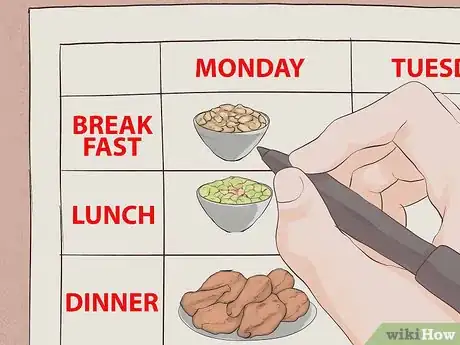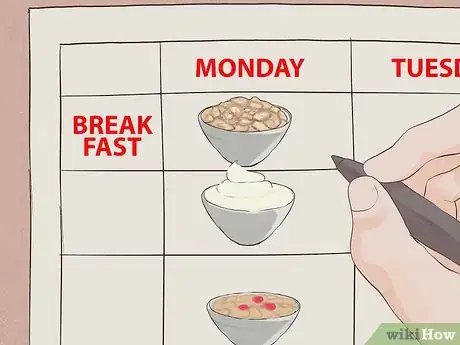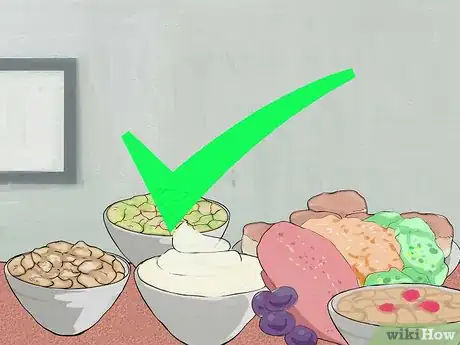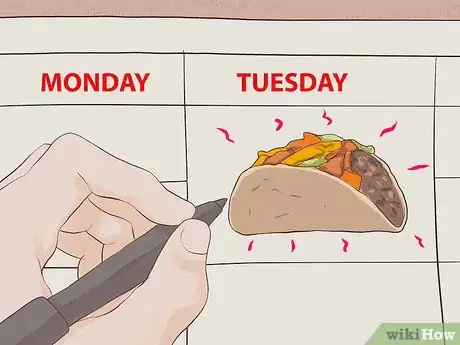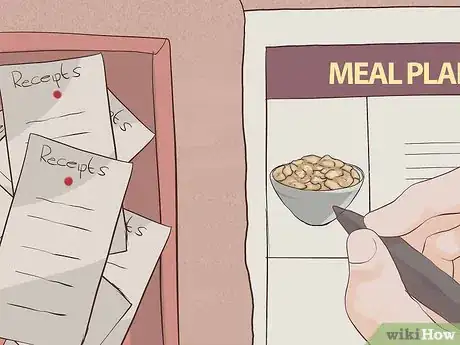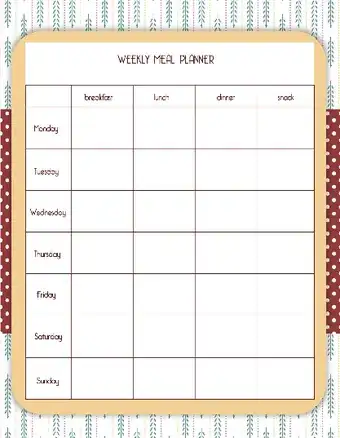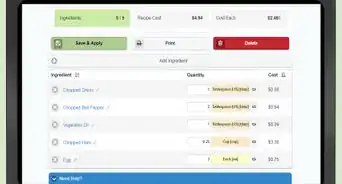This article was co-authored by Lyssandra Guerra. Lyssandra Guerra is a Certified Nutrition & Wellness Consultant and the Founder of Native Palms Nutrition based in Oakland, California. She has over five years of nutrition coaching experience and specializes in providing support to overcome digestive issues, food sensitivities, sugar cravings, and other related dilemmas. She received her holistic nutrition certification from the Bauman College: Holistic Nutrition and Culinary Arts in 2014.
There are 9 references cited in this article, which can be found at the bottom of the page.
wikiHow marks an article as reader-approved once it receives enough positive feedback. In this case, 83% of readers who voted found the article helpful, earning it our reader-approved status.
This article has been viewed 128,314 times.
Meal planning saves money, time, and makes eating healthy easier. With a well-thought out meal plan, you can make accurate grocery lists and waste less food, as you'll know exactly what you're using each ingredient for instead of just buying things and figuring out their use later.
Steps
Determining Your Meal Needs
-
1Count out how many meals, and what type of meal, you need to plan for. A good way to do this is to simply look back on the last week of meals. What days did you go out to eat? What days did you have left-overs? What days did you have plenty of time to make a great, huge meal? It is a generally a good idea to plan your meals for no longer than a week in advance, since plans can change and food might go bad. Jot down all the meals you ate last week and see how many meals, and what type, you need to plan for:
- Breakfast: Do you make a unique breakfast sometimes, or do you generally eat the same thing each morning?
- Lunch: Do you eat out while at work, or do you pack lunches?
- Dinner: What days do you cook? What days do you eat out or eat leftovers?
- Snacks: How quickly do you go through snack foods? Do you need these foods, or do you just eat them because you were around.[1]
-
2Draft up a basic calendar of the week with slots for every meal. Get a pen and paper and sketch out each day, putting three slots under each for breakfast, lunch, and dinner. You can even print out and use the template found at the bottom of the article, or get a free food planning app online.Advertisement
-
3Make a "master list" of your favorite recipes and meals. Collect your favorite recipes online and out of cookbooks, helping you quickly fill in your schedule with new meals. If you don't collect recipes or don't know where to begin, head online and search for recipes with some of your favorite ingredients, your schedule (ie. "1-hour dinners"), or simply peruse food blogs or websites. A quick internet search for "best recipes" will pull up far more food than you could ever conceivably try.
- Sites and apps like FoodGawker let you search recipes by style, time, ingredients (including ingredients you want to avoid) and popularity.
- Remember to look up sides too, like salads or vegetable dishes, and not just the main course.[2]
-
4Fill in simple or easily customized meals, like breakfast, first. In general, most people eat 2-3 things every day for breakfast and lunch, and don't often use recipes to determine cereal and milk choices. Note these meals on your calendar, then make a simple list of the various ingredients you might mix and match -- granola, cereal, fruit, yogurt, cold cuts, etc. There is no need to plan out exactly what you're getting now ("12 slices of turkey") before going to the store. Just write out ("12 slices of cold cuts"), then see what looks good at the store.
-
5Understand the basics of a well-balanced meal. Planning dinners may look daunting, as they are usually made up of 2-3 separate parts. However, the basics of a well-balanced meal are actually pretty simple. You want a main dish, usually a grain (pasta, rice, couscous, etc.), a protein like chicken, beans, or fish, and at least 1-2 vegetables or fruits.
- Think of each dinner as three separate parts -- a grain, a vegetable, and a protein. Pick three simple recipes instead of trying to make one all inclusive dish each night.
-
6Combine all of your recipes into your week's grocery list. Once you have all of your recipes compiled, simply mix and match the recipes together to create a shopping list. You know you'll use everything you buy since it all has a purpose in your week. You may add loose snacks here and there, but, in general, you should cut down on the time and money spent in the store considerably with proper planning.[3]
- Be sure to check your fridge and pantry before going to see what ingredients you already have.
- Some people find planning all meals daunting at first. If so, just start with dinners, then buy the rest of your groceries like normal.
-
7Be flexible every now and then. No one can plan for everything, and that's fine. Sometimes you may want some spontaneity, and some days you'll get home and just won't feel like cooking. A meal plan is there to make life easier, not bind you to some sort of eating contract.
- Try having a "cook's choice" night, which you leave open to figure out later that day. This is often a good choice for your shopping day, as you can easily buy the right ingredients for that night's meal on the fly.
- While meal plans are a good way to limit costly eating out, you should still free to head out every once and a while.[4]
Making Effective Meal Plans
-
1Find recipes that use similar ingredients to save money and time. Once you get the hang of meal planning, you'll realize it is a fantastic tool to spend your time and money more effectively. For example, find multiple recipes for the Brussels sprouts used on Monday and then buy them in bulk instead of buying a smaller, and more expensive, amount of sprouts. Choose recipes like stir-fries or fried rice that are easily customized at the end of the week, allowing you to throw in all your leftover onions, peppers, and other vegetables.
- For example, you might do a chicken salad one night and chicken tacos the next. You can cook all the chicken the first night, then reheat it in taco sauce or seasoning the next.[5]
-
2Engage your family when planning meals. There is no reason you have to do this all by yourself. Moreover, getting the whole family to send in recipes ensures that everyone gets to eat something they want. This is also a great way to help kids expand their palettes and make sure that they eat each night.
-
3Choose healthy options now to eat healthy throughout the week. When meal planning healthy recipes, you ensure that you eat healthy food. If you only plan healthy meals, you can can avoid a last-minute box of Mac and Cheese on days you're unsure what to eat. Planning around your schedule takes the stress off of you later in the week to find something healthy each night.[6]
-
4Buy produce that is in season or on sale to save money and eat fresher foods. Determining what is in season, and how to use it, is difficult at the store, but you can easily plan for seasonal fruits and vegetables at home and pick 2-3 recipes that make use of them. Check out what is on sale online when meal planning, then plan your recipes accordingly.[7]
-
5Make a "theme night" once a week, such as Taco Tuesdays or Pasta Wednesdays. This takes a whole day off of your calendar, making planning that much easier. It also lets you perfect that one option every week. When you're at the store, you can easily start mixing and matching the recipes depending on what is on sale, since you know generally what you'll need for Hot Salad Saturdays.[8]
-
6Check the weather to determine what nights you might want hot or cold foods. It is no secret that our food preferences change depending on the weather. So, if there is a cold rainy night coming up, prepare for grilled cheese and soups. If a heat wave is coming, look for meals that don't require tons of time over a hot oven or stove, like fresh salads or sandwiches.[9]
-
7Save your receipts and keep notes on your meal planning, adjusting accordingly. The first few weeks will be a little odd as you get used to your new system and make changes. Keep all of your receipts to track how much money you're spending, and write down what you think of each recipe. As you keep planning, you'll be able to adjust your schedule depending on changing finances, recipes you love, and currently available produce.[10]
Meal Plan Template
Expert Q&A
Did you know you can get expert answers for this article?
Unlock expert answers by supporting wikiHow
-
QuestionHow do I make a weekly meal plan?
 Lyssandra GuerraLyssandra Guerra is a Certified Nutrition & Wellness Consultant and the Founder of Native Palms Nutrition based in Oakland, California. She has over five years of nutrition coaching experience and specializes in providing support to overcome digestive issues, food sensitivities, sugar cravings, and other related dilemmas. She received her holistic nutrition certification from the Bauman College: Holistic Nutrition and Culinary Arts in 2014.
Lyssandra GuerraLyssandra Guerra is a Certified Nutrition & Wellness Consultant and the Founder of Native Palms Nutrition based in Oakland, California. She has over five years of nutrition coaching experience and specializes in providing support to overcome digestive issues, food sensitivities, sugar cravings, and other related dilemmas. She received her holistic nutrition certification from the Bauman College: Holistic Nutrition and Culinary Arts in 2014.
Certified Nutrition & Wellness Consultant
-
QuestionHow do restaurants plan meals?
 Community AnswerThe chef of the restaurant is generally in charge of meal planning.
Community AnswerThe chef of the restaurant is generally in charge of meal planning.
References
- ↑ https://blog.myfitnesspal.com/meal-planning-for-beginners/
- ↑ http://www.healthyeating.org/Healthy-Eating/Meals-Recipes/Family-Meal-Planning.aspx
- ↑ http://www.healthyeating.org/Healthy-Eating/Meals-Recipes/Family-Meal-Planning.aspx
- ↑ http://organizedhome.com/kitchen-tips/menu-planning-save-time-kitchen?page=2
- ↑ http://www.cookinglight.com/food/everyday-menus/six-steps-successful-menu-planning
- ↑ https://blog.myfitnesspal.com/meal-planning-for-beginners/
- ↑ http://organizedhome.com/kitchen-tips/menu-planning-save-time-kitchen?page=3
- ↑ http://www.healthyeating.org/Healthy-Eating/Meals-Recipes/Family-Meal-Planning.aspx
- ↑ http://www.thekitchn.com/10-tips-for-better-weekly-meal-planning-reader-intelligence-report-177252
About This Article
To start meal planning, gather a few recipes for the upcoming week and use the ingredients to create a grocery shopping list. If meal planning for the week feels overwhelming, try a few dinners to start. Once you get the hang of it, save money by building meals around produce that's on sale. To further save money and time, look for recipes that use similar ingredients. For example, find multiple recipes for brussel sprouts, buy them in bulk, and plan a stir fry for the end of the week to use any leftovers. To learn how to incorporate theme nights into your meal plans, keep reading!

